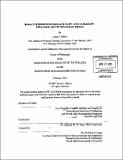Basalt petrogenesis beneath slow- and ultraslow-spreading Arctic mid-ocean ridges
Author(s)
Elkins, Lynne J
DownloadFull printable version (41.21Mb)
Other Contributors
Woods Hole Oceanographic Institution.
Advisor
Kenneth W. W. Sims.
Terms of use
Metadata
Show full item recordAbstract
To explore the ability of melting mafic lithologies to produce alkaline ocean-island basalts (OIB), an experimental study was carried out measuring clinopyroxene (Cpx)melt and garnet (Gt)-melt partition coefficients during silica-poor garnet pyroxenite melting for a suite of trace elements, including U and Th, at 2.5GPa and 1420-1450°C. Partition coefficients range from 0.0083+0.0006 to 0.020+0.002 for Th and 0.0094+0.0006 to 0.024+0.002 for U in Cpx, and are 0.0032+0.0004 for Th and 0.013+0.002 for U in Gt. Forward-melting calculations using these experimental results to model time-dependent uranium-series isotopes do not support the presence of a fixed quantity of garnet pyroxenite in the source of OIB. To use U-series isotopes to further constrain mantle heterogeneity and the timing and nature of melting and melt transport processes, U-Th-Pa-Ra disequilibria, radiogenic isotopes, and trace-element compositions were measured for the slow-spreading Arctic mid-ocean ridges (MOR). A focused case study of 33 young (<10ka) MOR basalts (MORB) from the shallow endmember of the global ridge system, the Kolbeinsey Ridge (67°05'-70°26'N) found that unaltered Kolbeinsey MORB have universally high (230Th/238U) (1.165-1.296) and relatively uniform (230Th/232Th) (1.196-1.324), ENd (8.4310.49), 87Sr/86Sr (0.70274-0.70301), EHf(16.59-19.56), and Pb isotopes (e.g. 208Pb/206Pb 2.043-2.095). This suggests a homogeneous mantle source and a long peridotite melting column produces the thick Kolbeinsey crust. Trace element ratios suggest a young, depleted mantle source. Data from the slow- to ultraslow Mohns and Knipovich Ridges north of Kolbeinsey form a sloped array, and (230Th/232Th) correlates systematically with radiogenic isotopic variations. (cont.) These data are readily reproduced by models for heterogeneous mantle melting. MORB from 85oE on the global ultraslow-spreading endmember Gakkel Ridge are homogeneously depleted with low (230Th/238U) and high (226Ra/230Th) that lie along a global negative correlation. Arctic data support a global mantle temperature control on mean (230Th/238U).
Description
Thesis (Ph. D.)--Joint Program in Marine Geology and Geophysics (Massachusetts Institute of Technology, Dept. of Earth, Atmospheric, and Planetary Sciences; and the Woods Hole Oceanographic Institution), 2009. Includes bibliographical references.
Date issued
2009Department
Joint Program in Marine Geology and Geophysics; Woods Hole Oceanographic Institution; Massachusetts Institute of Technology. Department of Earth, Atmospheric, and Planetary SciencesPublisher
Massachusetts Institute of Technology
Keywords
Earth, Atmospheric, and Planetary Sciences., Joint Program in Marine Geology and Geophysics., Woods Hole Oceanographic Institution.